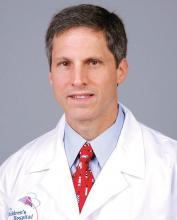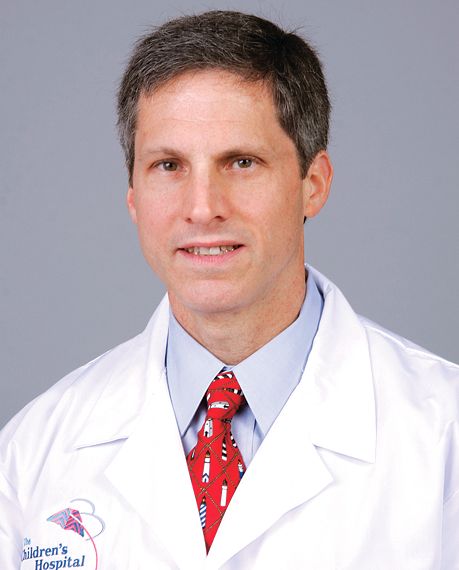User login
New developments in techniques and technology, particularly the use of simulators and virtual reality, are poised to improve radiation safety and will be showcased in the session, “Radiation Safety; Imaging, New Concepts and Devices,” on Thursday afternoon.
The session will be co-moderated by Dr. Evan C. Lipsitz, associate professor of surgery at Albert Einstein College of Medicine, and chief of the division of vascular surgery at Montefiore Medical Center, New York, and Dr. Lars B. Lonn, professor of vascular surgery and interventional radiology at the University of Copenhagen.
Dr. Götz M. Richter, professor of radiology, Klinik für Diagnostische und Interventionelle Radiologie, Stuttgart, Germany, will start off the session with tips on how to reduce radiation exposure during complex aortic procedures, and how virtual guidance systems will help. Next, Dr. Armando C. Lobato, post-graduate professor, Federal University of São Paulo, will speak on “Endovascular Repair of AAAs with Common Iliac Aneurysms: Comparison of Sandwich Grafts vs. Hypogastric Exclusion vs. Bell Bottom Technique.”
Safety gear continues to evolve, but Dr. Lonn will discuss the limitations of current equipment in his talk, “‘Light Weight’ Radiation Protective Gear (Caps, Glasses, Lead Gowns) Is a Misnomer: These Devices Fall Short: How Should Vascular Specialists Best Protect Their Brain, Eyes and Body From Radiation.”
Dr. Kyung Cho, William Martel Emeritus Professor of Radiology, University of Michigan, provides additional tips and tricks for safely performing CO2 angiography and CO2 guided interventions for the treatment of lower extremity and abdominal arterial lesions.
The session also includes presentations on the use of virtual and augmented reality, and how these technologies can be used to enhance operator radiation safety and improve surgeons’ technical skills without compromising patient safety. Dr. Lonn will begin this portion of the session with a talk on how a simulation system can help promote operator radiation safety.
Dr. Jan M.M. Heyligers, consultant vascular surgeon, Elisabeth Twee-Steden Hospital, will continue the subject the virtual reality, taking on the topic of “Virtual Reality, Augmented Reality, and High Resolution 3D-3D Imaging: What Are They and What Will Their Value Be?
Dr. Fabien Thaveau, professor of vascular surgery, Medical School of Strasbourg, will discuss the specifics of a particular system in a review of the Medtronic Tour Guide System and its potential value when used to assist with challenging catheterizations and procedures.
The session will then feature a presentation by Dr. Timothy K. Liem, professor of surgery, Oregon Health & Science University, on how to manage anticoagulation to avoid postoperative hemorrhage and a discussion of the use of a pressurized cadaver model to augment open vascular training by Dr. Christian Ochoa, assistant professor of surgery, Keck Medical Center of University of Southern California. The pressurized model is designed to simulate patient bleeding.
The take-home message from the session is “that reducing radiation exposure requires a multifaceted approach and that operators must be vigilant and keep abreast of new developments to achieve maximum effectiveness,” Dr. Lipsitz concluded.
New developments in techniques and technology, particularly the use of simulators and virtual reality, are poised to improve radiation safety and will be showcased in the session, “Radiation Safety; Imaging, New Concepts and Devices,” on Thursday afternoon.
The session will be co-moderated by Dr. Evan C. Lipsitz, associate professor of surgery at Albert Einstein College of Medicine, and chief of the division of vascular surgery at Montefiore Medical Center, New York, and Dr. Lars B. Lonn, professor of vascular surgery and interventional radiology at the University of Copenhagen.
Dr. Götz M. Richter, professor of radiology, Klinik für Diagnostische und Interventionelle Radiologie, Stuttgart, Germany, will start off the session with tips on how to reduce radiation exposure during complex aortic procedures, and how virtual guidance systems will help. Next, Dr. Armando C. Lobato, post-graduate professor, Federal University of São Paulo, will speak on “Endovascular Repair of AAAs with Common Iliac Aneurysms: Comparison of Sandwich Grafts vs. Hypogastric Exclusion vs. Bell Bottom Technique.”
Safety gear continues to evolve, but Dr. Lonn will discuss the limitations of current equipment in his talk, “‘Light Weight’ Radiation Protective Gear (Caps, Glasses, Lead Gowns) Is a Misnomer: These Devices Fall Short: How Should Vascular Specialists Best Protect Their Brain, Eyes and Body From Radiation.”
Dr. Kyung Cho, William Martel Emeritus Professor of Radiology, University of Michigan, provides additional tips and tricks for safely performing CO2 angiography and CO2 guided interventions for the treatment of lower extremity and abdominal arterial lesions.
The session also includes presentations on the use of virtual and augmented reality, and how these technologies can be used to enhance operator radiation safety and improve surgeons’ technical skills without compromising patient safety. Dr. Lonn will begin this portion of the session with a talk on how a simulation system can help promote operator radiation safety.
Dr. Jan M.M. Heyligers, consultant vascular surgeon, Elisabeth Twee-Steden Hospital, will continue the subject the virtual reality, taking on the topic of “Virtual Reality, Augmented Reality, and High Resolution 3D-3D Imaging: What Are They and What Will Their Value Be?
Dr. Fabien Thaveau, professor of vascular surgery, Medical School of Strasbourg, will discuss the specifics of a particular system in a review of the Medtronic Tour Guide System and its potential value when used to assist with challenging catheterizations and procedures.
The session will then feature a presentation by Dr. Timothy K. Liem, professor of surgery, Oregon Health & Science University, on how to manage anticoagulation to avoid postoperative hemorrhage and a discussion of the use of a pressurized cadaver model to augment open vascular training by Dr. Christian Ochoa, assistant professor of surgery, Keck Medical Center of University of Southern California. The pressurized model is designed to simulate patient bleeding.
The take-home message from the session is “that reducing radiation exposure requires a multifaceted approach and that operators must be vigilant and keep abreast of new developments to achieve maximum effectiveness,” Dr. Lipsitz concluded.
New developments in techniques and technology, particularly the use of simulators and virtual reality, are poised to improve radiation safety and will be showcased in the session, “Radiation Safety; Imaging, New Concepts and Devices,” on Thursday afternoon.
The session will be co-moderated by Dr. Evan C. Lipsitz, associate professor of surgery at Albert Einstein College of Medicine, and chief of the division of vascular surgery at Montefiore Medical Center, New York, and Dr. Lars B. Lonn, professor of vascular surgery and interventional radiology at the University of Copenhagen.
Dr. Götz M. Richter, professor of radiology, Klinik für Diagnostische und Interventionelle Radiologie, Stuttgart, Germany, will start off the session with tips on how to reduce radiation exposure during complex aortic procedures, and how virtual guidance systems will help. Next, Dr. Armando C. Lobato, post-graduate professor, Federal University of São Paulo, will speak on “Endovascular Repair of AAAs with Common Iliac Aneurysms: Comparison of Sandwich Grafts vs. Hypogastric Exclusion vs. Bell Bottom Technique.”
Safety gear continues to evolve, but Dr. Lonn will discuss the limitations of current equipment in his talk, “‘Light Weight’ Radiation Protective Gear (Caps, Glasses, Lead Gowns) Is a Misnomer: These Devices Fall Short: How Should Vascular Specialists Best Protect Their Brain, Eyes and Body From Radiation.”
Dr. Kyung Cho, William Martel Emeritus Professor of Radiology, University of Michigan, provides additional tips and tricks for safely performing CO2 angiography and CO2 guided interventions for the treatment of lower extremity and abdominal arterial lesions.
The session also includes presentations on the use of virtual and augmented reality, and how these technologies can be used to enhance operator radiation safety and improve surgeons’ technical skills without compromising patient safety. Dr. Lonn will begin this portion of the session with a talk on how a simulation system can help promote operator radiation safety.
Dr. Jan M.M. Heyligers, consultant vascular surgeon, Elisabeth Twee-Steden Hospital, will continue the subject the virtual reality, taking on the topic of “Virtual Reality, Augmented Reality, and High Resolution 3D-3D Imaging: What Are They and What Will Their Value Be?
Dr. Fabien Thaveau, professor of vascular surgery, Medical School of Strasbourg, will discuss the specifics of a particular system in a review of the Medtronic Tour Guide System and its potential value when used to assist with challenging catheterizations and procedures.
The session will then feature a presentation by Dr. Timothy K. Liem, professor of surgery, Oregon Health & Science University, on how to manage anticoagulation to avoid postoperative hemorrhage and a discussion of the use of a pressurized cadaver model to augment open vascular training by Dr. Christian Ochoa, assistant professor of surgery, Keck Medical Center of University of Southern California. The pressurized model is designed to simulate patient bleeding.
The take-home message from the session is “that reducing radiation exposure requires a multifaceted approach and that operators must be vigilant and keep abreast of new developments to achieve maximum effectiveness,” Dr. Lipsitz concluded.

